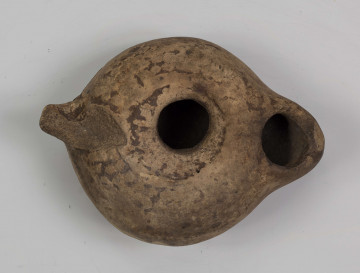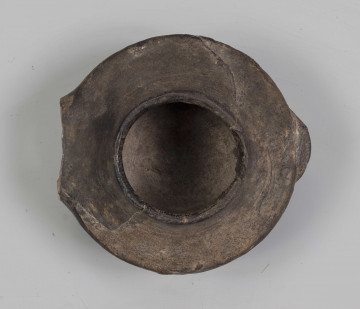
Oil lamp
50 — 100
National Museum in Lublin
Part of the collection: Archaeological monuments of the Lublin region
Olive lamps are among the most common antique exhibits in Polish museums. They often form part of old collections and are not dated. One of the four antique lamps in the collection of the National Museum in Lublin does not have an established origin. It has probably been in the museum collection since before World War II, similarly to nine missing lamps preserved only in the form of museum cards with an annotation about their origin from the "Bobolanum" (currently the Military Hospital on Racławickie Avenue in Lublin).
The Roman granulated lamp belongs to the so-called Warzenlampe type. It is made of light clay covered with slipware. The vessel is oval with an elongated, rounded burner, the disk is wide, slightly depressed, surrounded by relief, on the disk there are traces of a vice, high foot.
The lamp is one of the unusual miniatures that had cult significance or were used as toys. It is modelled on bronze Italian lamps. It can be dated to the 3rd century AD. It probably comes from a Pannonian workshop. Pannonia was a Roman province located between the Sava and the Danube. Other imports made of clay, such as terra sigillata vessels found in the Polish territory come from this area.
Author / creator
Dimensions
cały obiekt: height: 9 cm, width: , diameter: 5,1 cm
Object type
tool
Technique
firing
Material
clay
Creation time / dating
Creation / finding place
Owner
The National Museum in Lublin
Identification number
Location / status

50 — 100
National Museum in Lublin

201 — 400
National Museum in Lublin

201 — 500
National Museum in Lublin
DISCOVER this TOPIC
Museum of King Jan III's Palace at Wilanów
DISCOVER this PATH
Educational path